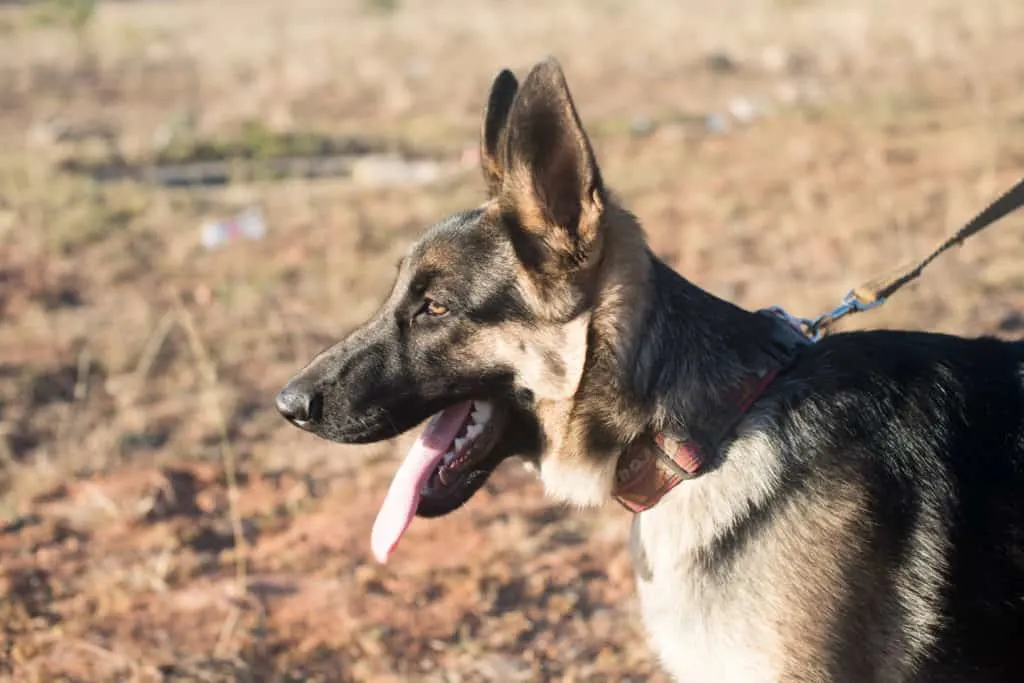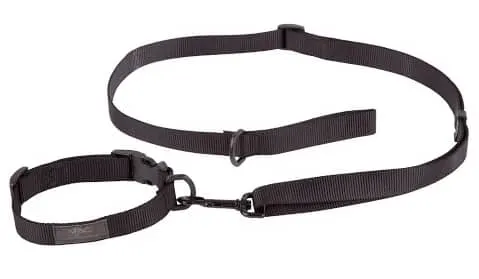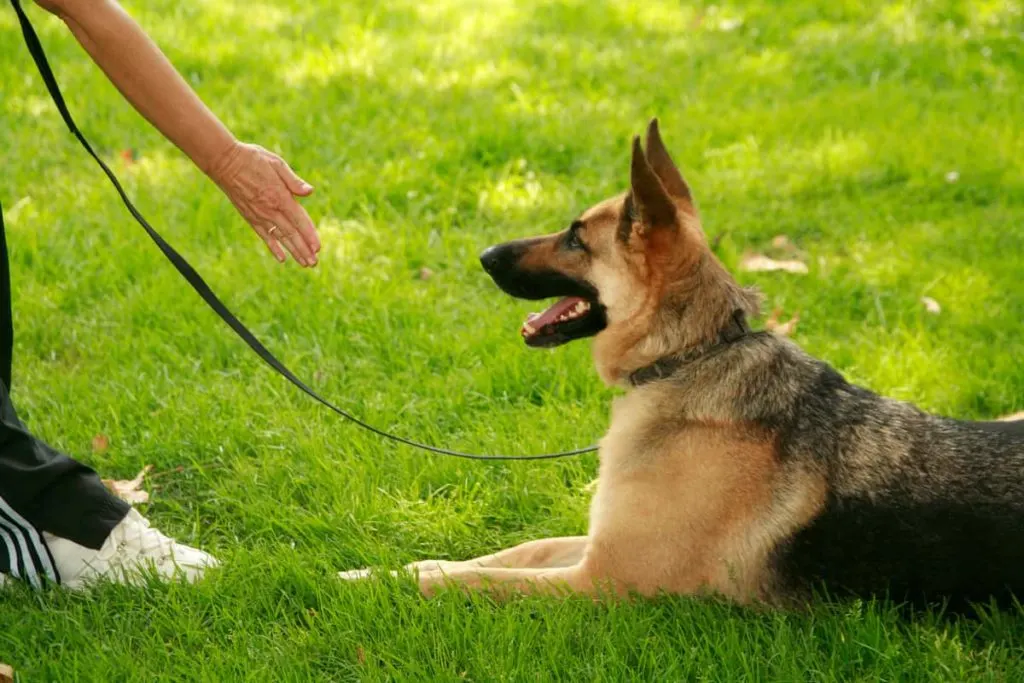
One of the most common problems German Shepherd owners face while trying to discipline their dog occurs while taking them out for walks. While out for a walk it is common for a GSD to pull on the leash and try to take the lead. However, this is not a behavior that you should allow. Doing so will teach your GSD that this is acceptable behavior.
So, how do you prevent your German Shepherd from pulling on the leash? In order to prevent your German Shepherd from pulling on its leash, it’s important to begin a leash training routine from a young age. During this routine, rules and boundaries for walks are established between the owner and the dog.
Older GSDs can also be leash trained, but this will present more of a challenge because older dogs’ habits are not easily changed.
Click Here to Jump to a Section
The Causes of Leash Pulling
- Curiosity: Because it is by nature an energetic and inquisitive dog, your GSD will have a natural curiosity about everything around it (think squirrels, birds, other dogs, people). Simple curiosity is a primary cause of constant leash pulling.
- Motion sensitivity: GSDs are herding dogs, and because of this, they are sensitive to motion. They instinctively direct their focus on anything that moves, as this is integral to moving and protecting herds of animals.
- Anxiety: In some cases, GSDs may be lacking confidence and they won’t know how to handle outdoor environments. This may cause them to pull on the leash just out of confusion and fear.
- Aggression: Some GSDs will not think twice about lunging at other dogs or people because their aggression has not been addressed through proper obedience training.
- Prior experience: In the event that you have adopted an adult GSD, they may pull on the leash to pursue something that may remind them of a past event in their lives.
When should you begin leash training?
It is important to start leash training a GSD when it’s young. While it is still possible to leash train a GSD when it’s a full-grown adult, there will be more challenges in part because of how much heavier and stronger it is.
Challenges may also arise because older dogs tend to be set in their ways. Old habits can be broken, but often take a considerable amount of effort.
So it is ideal to begin leash training your GSD when it is a puppy, because when you train it at a young age it will take what it learns and apply it as it grows up.
You should already have a plan to introduce leash training before you take your GSD puppy home.
The Right Collar and Leash to Use

When you take your GSD out for a walk, it is important to know which collar is the right one to use. There are many different types of collars to choose from, some work well and some don’t.
Avoid using collars that may harm or irritate your dog such as choke collars, metal chin collars, electronic collars, plastic collars, or pinch and prong collars.
If you begin training your GSD as a puppy then it is not necessary to use these collars. These types of collars only become necessary if you are training an adult that has preexisting ingrained habits.
Instead, for a puppy, simply use a standard inexpensive collar made from nylon or leather. This will be comfortable for your GSD and will not distract it from listening to you.
The Best Time to Train
When is the best time to leash train your GSD? Knowing that your GSD is a high energy dog, you should make sure to give it some exercise and some active playtime before you both go out for a walk.
The more excited your GSD is to walk the more likely leash pulling will happen. Before taking a walk you should spend around 10 minutes of leash training in the house to remind your dog of the rules.
Leash Training Methods
Before you begin to leash train your dog, it is important that you plan to approach the training in an organized manner.
Come up with a plan on regarding where you want to take your dog out for a walk. Preferably take your dog to a place where it’s been before.
Choosing a new place may hinder your dog’s ability to learn obedience because it could become too curious of the new environment.
A good way to help your GSD learn would be to train in a place that isn’t too crowded, such as areas near busy streets. You want an open space that allows minimally for distractions.
It is important to establish that you are the one in control of the walk, and not your GSD. So it is key that you don’t get frustrated with your dog.
Plan to stay calm while you train, and always expect some kind of setback when you first start training your GSD. As your dog’s owner, you are teaching it patience and obedience.
Patience doesn’t come naturally to all of us, but it is important to develop this skill within yourself to effectively leash train your GSD. Do not underestimate the importance of this.
Here are some leash training methods that you can choose from. Remember that all dogs will react differently to each leash training method.
Lure and Reward Method
You will need a lot of treats for this method, so choose small ones, or break up larger treats. Offering your dog a treat is the easiest way to get its attention.
- The first step to take in the Lure and Reward method is to make sure your dog is standing at your side. It is up to you which side you want your dog to be positioned.
- Next, get out a treat and show it to your dog.
- Begin walking, and every 5 steps, if you see your dog walking at your pace, feed it a treat and tell your dog how good it is. If your dog starts pulling ahead then immediately stop walking.
- Call your dog’s name and ask it to sit at your side. After your dog obeys resume walking again.
- Repeat the first three steps again. Slowly increase the number of steps you take in between the times you reward your dog.
Reverse Direction Method
- Begin your walk outside with your dog like you normally would. When your dog starts pulling on the leash, turn away from your dog and change your direction. Don’t quickly jerk on the leash when you do this. And don’t worry if your dog is reluctant to obey you in the beginning.
- Call your dog’s name and sound excited to get its attention. When your dog follows you in the new direction reward it with a treat and continue your walk in your original direction.
- When your dog pulls on the leash again, repeat the first two steps. The main point here is to teach your dog the difference between good and bad behaviors. When your dog completely understands that walking calmly by your side is good behavior reward it with a treat.
Clicker Method
If your dog is having trouble understanding your verbal cues in the beginning, then use a clicker to help. You can purchase a clicker at your local pet store.
- After your dog obeys a command, press the button on the clicker once.
- If your dog disobeys a command, don’t use the clicker. You only use the clicker to reinforce acceptable behavior.
- Don’t use the clicker like a weapon of punishment and point it at your dog. Calmly hold the clicker by your side.
- After your dog shows good behavior, reward it with a treat. Make sure you don’t give your dog the treat while you use the clicker, only after
If you have adopted a German Shepherd, to worry. It may take some extra time and persistence on your part, but you will still be able to use a clicker as an effective tool to leash train your dog.
You may want to consider taking your dog to a class for clicker training. There you will receive support from other dog owners and your dog will witness other dogs responding correctly as well. This can work to give both you and your dog more confidence and to shorten the learning curve.
Teach basic commands while your dog is leashed

Keep the training of your GSD simple. When you give your dog verbal cues, keep them to a single word.
- Basic commands like “sit”, “stay”, “come” and “heel” are enough for your GSD to understand. With practice, your dog will recognize and obey your commands. Again, when training your GSD, keep everything simple.
- Always make sure the commands you give your dog are positive reinforcements. For example, if you tell your dog to “come” and then did something to confuse it, then you would be doing what is known as “poisoning a cue.”
Poisoning a cue means that your command is no longer positively reinforcing your dog, and it will cause your dog to become disobedient because it becomes confused and no longer respects the commands that you are giving.
Always let your commands be welcoming, so don’t change your tone and yell at your dog or take something out of its mouth. Be positive.
Verbal Cues
When you praise your German Shepherd for obeying your verbal cues, you should sound happy and reassuring. As time goes on and your dog gets comfortable with the basic commands, you can start introducing more advanced verbal cues.
Sit
The ‘Sit’ command is one of the most important commands for your dog to learn.
- Tell your dog to sit and help them plant their bottom to the ground.
- Don’t force your dog to sit down by pushing down on its back legs. Instead, you should take a step toward your dog and slightly lean over it.
- As you lean over your dog make sure it keeps eye contact with you. If it isn’t making eye contact then step back and tell it to watch you.
Stay
The ‘Stay’ command teaches your dog to simply remain in its current position.
- Begin by having your dog sit.
- Start walking away from your dog, but maintain eye contact with it while giving this cue.
- If your dog gets up at any point to follow you, go back to the beginning and have your dog sit again. Then repeat steps 1 and 2.
Come
This is a basic command that can be hard to teach if your dog is easily distracted.
- Start by letting your dog go wherever it wants. Give your dog a treat if it needs motivation in the beginning.
- When you tell your dog to come, gently tug on the leash. The tug is to get your dog to understand what this verbal cue means.
- As your dog returns to you have a treat prepared for it at the end of the leash.
- Don’t correct your dog if it doesn’t return to you right away. Give your dog time to understand how to come to you. Once your dog is comfortable with this command you can start removing the leash.
Heel
Having your dog heel means for it to walk right alongside you.
- Make sure that your dog stands close to your side, and that you both are facing the same direction.
- Call your dog’s name. Once they make eye contact with you, take a couple of steps forward and then stop.
- If your dog moves with you and then stops when you stop, give it a treat. Your dog has successfully performed the heel.
Final thoughts
The mindset of a German Shepherd can be instilled or even changed as long as you have the proper mindset for leash training. It is up to you to balance the system for rewarding and punishing your dog.
You want to make your dog feel good for doing good, but also constructively correct your dog when it doesn’t obey.
Once your dog is confident and comfortable listening to you, your walks together will be a joy. Don’t get frustrated, and don’t give up. With patience and time you will see your hard work come to fruition.
–
